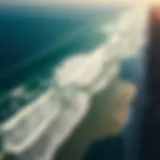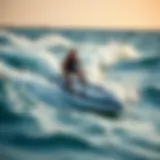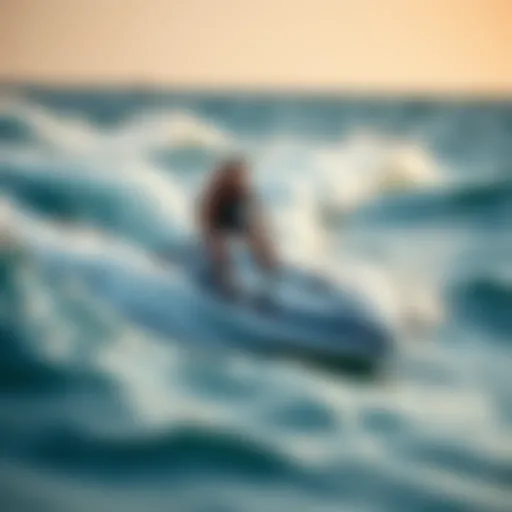Understanding Wind Effects on Surfboarding


Intro
Surfing, a dance with the ocean, hinges on many variables, but perhaps none are as pivotal as the wind. It's the invisible artist shaping waves and the surfer’s experience. From the gentle breezes that seem to whisper to you as you paddle out, to the fierce gales that send you tumbling, understanding wind direction is essential for every surfer, whether you're wading through your initial lessons or you're an old pro.
One might wonder why wind holds such sway over waves. It’s simple yet intricate. As the wind blows across the surface of the water, it generates friction, transferring energy and creating the waves we ride. Each gust, each shift in direction, transforms the ocean’s canvas, impacting everything from wave height to shape. Thus, navigating the winds of change becomes crucial—knowing what wind patterns signal ideal surf conditions can mean the difference between a thrilling session or a floundering one.
"Wind is the breath of the ocean; without it, even the mightiest waves become mere ripples."
This article will dive into the world of wind dynamics and their impact on surfboarding. You’ll gain insights into:
- How different wind directions affect wave formation.
- Practical tips for assessing wind conditions.
- The unique interplay between meteorology and surfboarding.
- Advanced strategies for picking the best surf spots based on wind behavior.
As we embark on this journey, we’ll break down complex ideas into straightforward language. After all, even from the shore, the ocean can appear overwhelming; but, with the right knowledge, surfers can feel empowered, capable of embracing whatever the wind brings.
Understanding Wind Dynamics
Wind plays a pivotal role in surfing, acting as both a friend and foe to surfers around the globe. Understanding wind dynamics equips surfers, from novices to pros, with the knowledge to improve their performance and make informed decisions about when and where to hit the waves.
In the world of surfboarding, wind is not just a passing concern; it can dictate the entire experience. Its presence influences wave formation, alters wave quality, and even affects surfer safety. Ignoring the intricacies of wind can leave surfers floundering, while those who harness this knowledge often find themselves riding some of the best swells. Additionally, a deeper grasp of wind dynamics can help surfers predict conditions based on local weather patterns, enhancing their overall experience on the water.
Defining Wind and Its Types
Wind is simply the movement of air from areas of high pressure to low pressure. Though it may seem like a straightforward concept, wind actually comes in various types. Understanding these can be helpful for surfers picking their spots.
- Local Winds: These winds affect an area on a day-to-day basis and can greatly change surface conditions in short time spans. For example, an onshore breeze, which blows from the sea toward the land, might flatten already formed waves, making them less favorable for surfing.
- Trade Winds: These are the steady winds that blow towards the Equator, primarily influencing tropical regions. They can create consistent surf conditions during certain seasons, making some areas more appealing for surf trips.
- Offshore Winds: Recognized by surfers as favorable winds, these blow from the land toward the ocean. They can clean up the waves and keep them open and well-formed.
- Storm Winds: These winds arise during storms and can create unpredictable, sometimes dangerous conditions. Surfers should approach storm-driven waves with caution.
The Science Behind Wind Formation
Wind is a result of the sun's uneven heating of the Earth's surface. This heating leads to differences in air pressure, prompting air to move from high to low pressure zones. The greater the difference in pressure, the stronger the wind.
For surfers, recognizing the patterns of wind formation can lead to discovering which times of year or times of day yield the best surf conditions. Some key factors influencing wind formation include:
- Geographical Features: Mountains can block winds, while coastlines can channel them, often creating unique surf conditions.
- Temperature Changes: On sunny days, land heats up quicker than the ocean, leading to breezy afternoons ideal for quicker rides.
- Weather Systems: Fronts can change wind directions and intensities rapidly, which can create both opportunities and challenges for surfers.
How Wind Influences Weather Patterns
Wind patterns dictate not only the surfing conditions but also the broader weather of a region. These influences can be widespread:
- Pressure Systems: High-pressure systems generally bring clear skies and ideal surfing conditions, while low-pressure systems can bring clouds and storms.
- Ocean Currents: Winds help drive ocean currents that affect temperature and wave generation. A warm ocean can inspire stronger storms and larger waves, leading to epic surf days.
- Seasonal Changes: Wind direction and strength change with seasons, impacting surf conditions. For some locations, winter months may accentuate offshore conditions, creating a surfer's paradise.
"Understanding the wind is akin to understanding the ocean; both elements are intertwined as they create the conditions that surfers cherish or dread."
Grasping wind dynamics is essential for any surfer. It shapes waves, predicts conditions, and clarifies when it’s time to hit the surf or stay ashore. Making sense of the winds might just be the ticket to smoother rides and fonder memories on those salty shores.
The Role of Wind in Surfing
Understanding the role of wind in surfing is absolutely crucial for surfers who want to maximize their ride. Wind does more than just make the waves choppy; it's a key player in how those waves form, how they break, and ultimately how enjoyable and safe the surfing experience is. By delving into wind's influence, you can make informed choices about when and where to surf, tailoring your adventures to the unique dynamics of each location.
Wind and Wave Dynamics
Waves don’t just appear out of thin air. They’re born from the wind, and the relationship between wind and waves is intricate. Wind generates waves through friction as it blows across the water's surface. The faster the wind, the larger the swell it creates. This process—called wind fetch—depends on the uninterrupted distance from which the wind blows. As these waves travel, they can gain momentum, creating fantastic surf conditions.
Different wind directions can also affect how waves break. A shoreward wind can enhance the shape of the waves, whereas a crosswind might cause them to close out prematurely. Therefore, knowing the wind direction can dramatically influence the wave quality. Think of it this way: if wind is a painter, then waves are the canvas. The right conditions create a masterpiece, while chaotic winds may produce a rushed sketch.
Optimal Conditions for Surfing
When it comes to surfing, finding the sweet spot is key, and this is where wind plays a leading role. Optimal surfing conditions typically arise when the wind is light and offshore. This means the wind blows from the land towards the sea, which helps to hold the wave up longer as it peaks, allowing for cleaner and better rides.
Conversely, onshore winds tend to make surf conditions less favorable as they create choppy surface conditions and can deform or kill the wave completely. Surfers often keep a keen eye on wind forecasts, looking for those days when the winds are calm or blowing in the right direction.
A combination of factors—like swell height, period, and wind direction—dictate the ideal surfing day. Savvy surfers will be out there with the first rays of dawn, chasing that perfect set before the winds kick up. So, just like a farmer watches the weather, surfers should stay attuned to the forecast.
Categorizing Wind Effects on Surf Quality
Not all winds are created equal, and understanding their varied impacts on surf quality is essential. Here are a few categories that surfers can consider:
- Offshore Winds: These are your best friends in surfing. They help to create clean waves with nice, defined peaks.
- Onshore Winds: These winds can mess up good conditions, introducing turbulence that shortens rides and causes those once-beautiful waves to become disjointed.
- Crosswinds: They can create rip currents and rough surfaces. Depending on their strength, they can either make for tricky surfing or offer a unique challenge.
- Variable Winds: Winds that shift can create unpredictable conditions. One moment the waves might be perfect, and the next, they might be less than ideal.
"Wind is the invisible hand that shapes our ride. Respect it, and it might just show you the way to the best surf of your life."
Ultimately, the dance between wind and surf is like any relationship—understanding its ebb and flow will enhance the overall experience and keep surfers coming back for more.
Reading Wind Directions
Understanding how to read wind directions is crucial for surfers who want to optimize their riding experience. The relationship between wind and waves should not be overlooked, as it can mean the difference between a fantastic session and a disappointing day at the beach. Knowing how to interpret wind directions specifically means figuring out how the wind flows and affects the surf, which is important for everyone from seasoned pros to casual boarders.
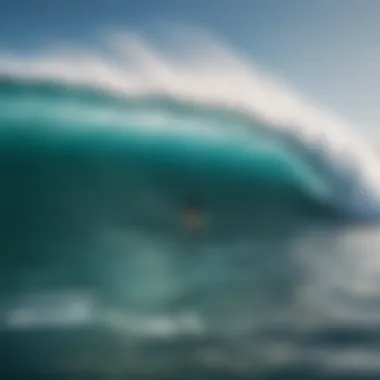

Identifying Wind Patterns
To successfully navigate surf conditions, you must first grasp the fundamentals of wind patterns. Each surf spot has its unique characteristics influenced by local geography and wind direction. When analyzing wind patterns, pay attention to their source—whether they are offshore, onshore, or cross-shore winds.
- Offshore Winds: These winds blow from land to sea, creating smooth, clean waves that are ideal for surfing.
- Onshore Winds: When the wind blows from the sea towards the shore, it can create choppy waves, making for a less favorable surfing experience.
- Cross-Shore Winds: These carry wind parallel to the shoreline. Depending on the strength, it can either make the conditions slightly tricky or enhance your wave riding.
It is important to observe local weather patterns and the typical wind flow specific to your chosen surfing locale. Ultimately, recognizing these wind patterns helps surfers decide the best time to hit the water and what conditions to expect.
Using Wind Forecasting Tools
Knowledge is power, especially when it comes to surfing wind conditions. By using forecasting tools, surfers can stay ahead of the game. These tools provide essential information about wind strength and direction, allowing surfers to plan accordingly.
Most smartphones today come with weather applications that provide real-time updates on wind conditions. Popular platforms like Windy and Surfline have advanced forecasting systems, giving detailed insights into wind speeds and waves. Learning how to effectively utilize these tools can significantly boost your surfing experience:
- Setting Location Alerts: Some apps let you set alerts for your desired surf spots, notifying you when conditions are optimal.
- Interactive Maps: Real-time maps can show exactly how wind changes over time, helping you pinpoint the right moment to head out.
- Historical Data: Reviewing past conditions can also aid in identifying trends, giving you a leg-up when planning for your next session.
Interpreting Local Surf Reports
Being tuned into local surf reports is paramount for any surfer. These reports often incorporate a variety of factors, such as wind speed, wave height, and swell direction.
Finding reliable surf forecasts can make your time spent in the water much more enjoyable. Consider these elements when interpreting local reports:
- Current Conditions: Look for real-time updates on wind direction and its effect on both wave quality and safety.
- Swell Forecasts: Combined insights about swell size and direction will provide clarity on how wind interacts with these elements.
- Recommendation and Guidance: Some reports come with advice tailored specifically to surfers of different levels, helping them make informed decisions.
In essence, mastering the art of reading wind directions arms surfers with the knowledge they need to enhance their surfing experience. It’s like having a cheat sheet; understanding how to identify wind patterns, properly utilize forecasting tools, and interpret local reports sets you up for success in the water. This knowledge will not only elevate your surfing game but will make every trip to the waves a worthwhile venture.
Forecasting Wind: Techniques and Tools
Understanding wind patterns is crucial not only for perfecting your surfing skills but for safety too. Accurately forecasting wind can mean the difference between an exhilarating ride and a day wasted chasing waves that never materialize. It’s like getting the wind at your back instead of facing it head-on; knowledge is power, especially for surfers. The fishing adage holds true here: "a little prep today saves a lot of grief tomorrow."
Meteorological Apps for Surfers
The rise of smartphone technology has ushered in a new era for surfers who rely on wind conditions. Apps like Surfline, Windy, and Magicseaweed are make-or-break tools for modern wave chasers. These platforms allow surfers to access real-time data regarding wind speed, wave height, and even tide schedules. Here’s a quick rundown of their advantages:
- Real-Time Updates: You’ll never miss an opportunity with alerts that keep you informed about changing conditions.
- User-Friendly Interfaces: Most apps come with intuitive designs, meaning you don't need a meteorology degree to navigate them.
- Location-Specific Information: Using GPS, they provide details tailored to your favorite surf spots, which is a game changer.
In addition, many of these apps let users share their own reports and experiences, creating a vibrant community that thrives on shared knowledge.
Understanding Weather Maps
Weather maps might seem daunting at first, but understanding them gives surfers a strategic advantage. Think of this as your surfboard's radar; knowing what's out there helps you to decide where to ride the waves successfully.
Key elements on these maps include:
- Isobars: Lines connecting points of equal pressure. Closer lines mean stronger winds.
- Wind Indicators: Arrows that show both the direction of the wind and its speed. These indicators can help predict how wind will affect wave shape and quality.
- Fronts: Areas where warm and cold air masses meet. They can cause abrupt weather changes, impacting surf conditions drastically.
By interpreting these symbols, a surfer can anticipate changes that may alter their day on the water. Regularly checking such maps, you can plan your surf excursions so you align them with optimal conditions.
Wind Prediction Models
Behind the scenes, numerical weather prediction models do the heavy lifting when it comes to forecasting. These models use complex calculations based on current weather data to predict how wind patterns will evolve over time. They consider various factors like atmospheric pressure, temperature, and humidity.
Surfers can leverage these models through resources such as:
- NOAA’s GFS Model: Provides reliable forecasts for the wind globally.
- NAM Model: Useful for localized forecasts, focusing on shorter periods.
- High-Resolution Models: These allow for more precise predictions, particularly over small areas.
Using these advances, surfers can look days ahead and prepare for peak conditions. As the wind patterns ebb and flow, having knowledge of these models can help mitigate risks while maximizing fun.
"When it comes to surfing, knowing the wind is knowing the surf. Misread the forecast and you might just find yourself swimming instead of riding high."
In summary, the toolbox for forecasting wind is ever-expanding, and becoming well-acquainted with these techniques and tools can give any surfer an edge. With the right information at their fingertips, surf enthusiasts can track conditions with precision, leading to safer and more rewarding experiences on the water.
Wind Variables in Specific Surf Locations
Understanding wind variables in specific surf locations is indispensable for surfers looking to maximize their experiences on the water. Every coastline behaves differently in relation to wind patterns, significantly affecting wave quality and surfability. We dive into the nuances of coastal regions and their unique wind signatures that can make or break your surf day.
Coastal Regions and Wind Patterns
Different coastal regions around the globe exhibit distinctive wind patterns that contribute to their surf dynamics. In some areas, winds blow consistently from the sea, enhancing the swells. For example, the beaches of San Diego often benefit from offshore winds that create clean, well-formed waves. In contrast, regions like the Eastern Seaboard can experience onshore winds that may chop up the waves, making them less ideal for surfing.
It’s crucial for surfers to familiarize themselves with the local wind behaviors in these regions since they can change from season to season.
- Types of Coastal Winds:
- Seasonal Influences:
- Offshore Winds: Originating from land towards the sea, they can groom waves, making them smoother and easier to ride.
- Onshore Winds: These winds flow from the ocean toward land, often introducing chop and inconsistencies to the wave faces.
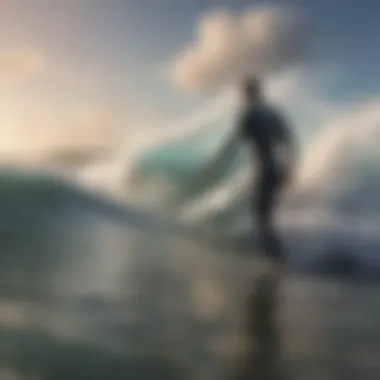

- Regions with notable seasonal shifts may see different wind patterns, making it essential to stay updated on local forecasts.
Effect of Geography on Wind Behavior
Geographical features play a significant role in shaping how wind interacts with the ocean. Islands, cliffs, and bays can modify wind patterns remarkably. For instance, a tall cliff can create a wind shadow, resulting in calmer waters just below it. Similarly, narrower inlets can amplify wind speeds as they funnel through these natural constructs.
When surfing in these unique locales:
- Understand Local Features:
- Conduct Reconnaissance: Observing how geography modulates wind behavior over time is key. Sometimes, just stepping away from the crowded spots can reward you with pristine conditions.
- Islands may block the wind, leading to more favorable conditions on certain sides.
- Reefs can alter wave setups, affecting how wind impacts the surf.
Identifying Prime Surfing Locations by Wind
Finding the best surfing spots based on wind conditions takes a keen eye and knowledge of local surf areas. Wind direction and speed can determine whether a location is rideable or not. Surfers often rely on surf reports, but a deeper understanding of how to read changes in wind conditions is invaluable.
- Use Local Knowledge:Learning from seasoned surfers about where to go depending on the wind can save you time and enhance your session.
- Monitor Wind Forecasting Tools:
- Check apps like Windy or Magicseaweed. They provide not only forecast but also real-time conditions.
- Identifying locations where the wind is favorable, such as spots with predominantly offshore conditions, can mean the difference between a mediocre session or an epic day of riding.
"Wind is the unseen artist that shapes our ocean canvases — knowing its temperament is key to mastering the surf."
In summary, understanding wind variables in specific surf locations is paramount for optimizing your surfing adventures. By dissecting the intricate dynamics of coastal winds, geographical influences, and wind-related tips, surfers can make informed decisions and ultimately enhance their experiences on the waves.
Wind Direction and Surfing Safety
Understanding the connection between wind direction and safety in surfing is paramount, especially when the ocean can be unpredictable. It’s not just about riding waves; it’s about living to tell the tale. The wind plays a crucial role in determining not only wave size but also the behavior of the water. Surfing without acknowledging these elements can be as dangerous as daring to dive into unknown waters.
Recognizing Dangerous Wind Conditions
When it comes to wind, not all breezes are created equal. Some winds can signal trouble, while others enhance conditions for a thrilling session. Surfers must hone their abilities to recognize wind conditions that can lead to perilous situations, such as strong onshore winds that can create choppy waves and disorient surfers. These winds may also lead to development of rip currents, which can pull even the most experienced surfer out to sea.
One must look out for:
- Consistent, strong winds from the land to the sea.
- Sudden changes in wind direction.
- Visible whitecaps forming on the waves as an indicator of rough water.
It’s essential to check local forecasts and listen to any warnings from lifeguards. They have the experience to assess when the wind turns dangerous.
Assessing Rip Currents and Wind Interactions
Rip currents are usually a result of wind-driven waves, and the interplay between these two factors can be complex. Occasionally, a storm's distant winds kick up swells that approach the beach. If the wind shifts and grows in strength, it may create difficult conditions for even seasoned surfers.
Surfers should be aware of the following:
- Look for gaps in breaking waves, as this often indicates where a rip current may be present.
- Observe the water's color; darker water may signify deeper areas where currents can be strong.
- Pay attention to rescues: if lifeguards become increasingly active, it’s time to reconsider going out.
Always be prepared to react swiftly if you find yourself caught in a rip current. Remember, they are not a solid wall of water; if you swim parallel to the shore, you can escape safely to shallower waters.
Guidelines for Safe Surfing Amid Wind Changes
Situational awareness is key when it comes to safety in surfing, particularly during wind changes. Here are a few essential guidelines to follow:
- Stay Informed: Regularly check surf reports and reliable weather apps to stay updated on changing conditions.
- Buddy System: Surfing with a friend not only adds fun but can also enhance safety. Your buddy can keep an eye on you, especially during sudden changes.
- Be Ready to Adapt: If conditions worsen, be prepared to modify your approach or exit the water. Safety should always come first.
- Trust Your Instincts: If something feels off, get out of the water. No wave is worth risking your life.
Adapting quickly to wind shifts and their effects can make the difference between a great surfing session and a dangerous one. As the adage goes, better safe than sorry.
"Surfing is about feeling the ocean and letting its rhythm guide you. Wind can feel like a dance partner. If you find yourself out of sync, don't hesitate to step back and reassess."
In the ever-changing landscape of wind and water, surfers must prioritize personal safety while remaining aware of environmental cues. By learning to read the winds, you can enjoy thrilling rides without compromising your well-being.
Adapting Surfing Techniques to Wind Conditions
Wind can be a double-edged sword for surfers. While it can enhance wave quality, it can also throw a wrench in a perfect session. Adapting your surfing techniques to wind conditions is paramount for maximizing your time on the water. Understanding how to navigate these elements leads not only to improved performance but also to a more enjoyable experience.
Adjusting to wind isn’t just about reacting; it's about being proactive. Planning surf sessions requires knowledge of how different strengths and directions can affect the surf. For instance, cross-shore winds can help in shaping cleaner waves, while onshore winds often disrupt them, making them choppy and less rideable. Learning these nuances isn’t solely for seasoned surfers—it’s vital for all skill levels.
Adjusting Your Board for Windy Days
When the wind picks up, it’s essential to tweak your gear accordingly. This starts with recognizing that your board can behave differently under variable wind conditions. A more buoyant board, such as a fish or a funboard, can be advantageous on windy days. Such boards tend to offer greater stability, helping you navigate turbulent waters with ease.
- Wider Boards: Opting for a wider design can provide better balance in gusty conditions.
- Thinner Rails: If you’re feeling adventurous, thinner rails can penetrate the water better, enabling quicker turns.
Furthermore, adjusting your fin setup can greatly influence how your board reacts. Larger or more fins can offer increased grip, especially if you anticipate harder winds. Changing from a thruster to a quad setup might also add that extra maneuverability needed when battling persistent gusts.
Tactical Approaches for Varied Wind Directions
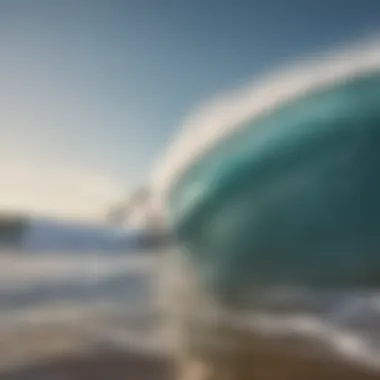

Understanding the wind's direction is crucial and, believe me, it’s not just small talk among surfers. Wind direction could dictate the difference between a rippable wave and a messy one. If you know the wind's influence, you’ll surf smarter, not harder.
- Offshore Winds: Ideal for surf, they create cleaner, peaky waves. Surfers should position themselves seeking the peaks, where the wind ensures longer rides.
- Onshore Winds: They can flatten and mush up waves, so it pays to know the spots where the waves might still hold up despite the onslaught.
- Cross-Onshore Winds: Mastering a strategy that takes advantage of these means seeking out the protection of rocks or jetties where the effect isn't as drastic.
Adapting your approach based on these wind-driven conditions not only adds to your performance but also allows for better timing and positioning.
The Importance of Timing with Wind Changes
Timing is everything, especially when it comes to wind changes. Experienced surfers often note that the best waves arrive just before significant shifts in wind direction occur. Keeping an ear to the ground, or rather the surf reports, could be your golden ticket.
Surfers must observe subtle shifts in wind. Here’s how it plays out:
- Go Early: Early mornings are typically wind calmer. Chances are you’ll find glassy, rideable waves.
- Watch the Horizon: Anticipating a wind change can be crucial. If you notice clouds forming or a shift in weather, it might be time to catch as many waves as you can before conditions deteriorate.
- Plan for Change: Having a flexible mindset about when to hit the water is beneficial. Some surf spots can go from hero to zero quickly, so knowing when to race out may mean the difference between a stellar session and a washed-out experience.
"Mastering the art of surfing is not just about riding waves; it's about riding the winds behind them."
Ultimately, it’s this adaptability that separates great surfers from the rest.
Chasing the Winds: Surfing Destinations
Understanding the nuances of wind direction is crucial for surfers, as it plays a pivotal role in determining optimal surfing conditions. This section explores global surfing destinations, seasonal variations, and the invaluable local knowledge that can set surfers up for success. Knowing where to chase the winds not only enhances the experience but also significantly impacts a surfer's performance.
Top Global Locations Based on Wind Patterns
For every avid surfer, finding the perfect wave is a quest often dictated by the wind. Different spots around the globe boast unique wind patterns, creating ideal conditions for riding. Consider the following locations:
- Hawaii: Renowned for its consistent trade winds, the North Shore of Oahu becomes a playground in winter months, producing world-class waves like those at Pipeline.
- Gold Coast, Australia: Famed for its point breaks, the south-east trade winds here shape pristine waves year-round, particularly from April to October.
- Jeffreys Bay, South Africa: Known for its super long right-hand point break, winds primarily from the east create perfect conditions during the winter months.
- Nazaré, Portugal: With its unique underwater canyon, the wind pattern here generates massive swells that attract big wave surfers from around the globe.
Each of these locations exemplifies the relationship between wind dynamics and surf prowess, allowing riders to harness nature's forces to their advantage.
Seasonal Variations in Surfing Conditions
Surf seasons vary dramatically across the globe, dictated largely by shifts in wind patterns.
- Summer: More often than not, the summer season witnesses light winds, often lending itself to smaller, more manageable rollers, perfect for beginners. Spotting these conditions is essential for family-friendly surf trips, particularly at beaches like Santa Monica or Maui.
- Winter: Conversely, winter storms can set up ideal conditions for seasoned surfers to tackle large swells. Places like Trestles in California showcase spectacular breaks when the winds shift south-east, aligning with winter storms in the Pacific.
- Spring and Fall: These shoulder seasons can often yield the best surprises, as winds begin to stabilize. Transitional waves can offer opportunities for advanced surfers to play around with techniques in fluctuating conditions.
Understanding these seasonal variations is critical. Surfers must stay informed about how the winds change with the seasons to catch the best waves.
Local Knowledge: The Key to Spotting Optimal Winds
While weather forecasts and maps are helpful tools, nothing beats the insight gleaned from local surfers. Knowledge passed down through generations can pinpoint the best times to surf specific spots.
- Talking to Locals: Engaging with local surf shops or fellow enthusiasts can unlock valuable insights about hidden gems that might not make official surf reports.
- Observing Patterns: Wind and wave patterns can vary dramatically even across a few miles. Regular surfers often take the time to observe how conditions change through the day, developing a nuanced understanding that can only come from experience.
- Utilizing Social Media and Forums: Platforms like Reddit and Facebook groups centered around surfing can provide rapid updates about local conditions. Utilizing these resources allows surfers to stay current and adapt plans on the fly.
In the world of surfing, knowledge is power. When it comes to understanding wind conditions and how they influence waves, local expertise cannot be underestimated.
"The best sessions often happen when you're in tune with the wind and its patterns; there's no substitute for local wisdom."
Ultimately, discovering and navigating the winds of change takes practice, observation, and a willingness to learn from those who've ridden before. As surfers chase the winds to their best destinations, they should arm themselves with the knowledge and tools necessary to make informed decisions.
This exploration into surfing destinations highlights just how deeply intertwined the surfer's experience is with the winds and waves. Embracing this connection can open up a world of possibilities, ensuring that every session is one for the books.
The Future of Surf and Wind Interaction
As we gazes into the horizon of surfing, it’s clear that the dance between surf and wind is changing, propelled by a combination of natural shifts and human interventions. Understanding the future of this relationship matters—not just for the seasoned surfers but also for those who shape the surf industry. This section delves into the crucial aspects influencing the way surfers will engage with wind in the years ahead, illuminating thoughts on climate change, technology, and sustainable practices.
Impact of Climate Change on Wind Patterns
Climate change is not just an environmental issue; it’s a game changer for surfboarding too. With the atmosphere warming, we're seeing a shift in wind patterns that could enhance or diminish our beloved surfing conditions. For instance, areas that were once known for favorable winds might face unpredictable gusts, altering wave quality. In coastal regions like California, studies have shown increased intensification of storms leading to not just higher waves, but also potentially dangerous conditions.
- Changing Weather Predictions: The rise in sea temperatures influences the local climate, which can disrupt regular wind patterns. This variability can lead to unexpected surf conditions that require surfers to adapt quickly.
- Extreme Weather Events: More frequent hurricanes or severe storms could reshape coastlines, affecting the spots we seek out for our rides. It’s a reminder how deeply intertwined surfing livelihood is with Mother Nature’s whims.
In sum, surfers need to stay updated on these shifts, employing robust forecasting tools to adjust their plans and maximize their experience amidst these environmental changes.
Technological Advances for Surfers
The surge in technology is revolutionizing the surfing world at a pace we could only have imagined a decade ago. With each new advancement, surfers are presented with powerful tools that help them interact with wind patterns more intelligently.
- Smart Wetsuits and Boards: Certain brands have introduced boards that utilize sensors to analyze conditions live, feeding data about wind speed and direction. This immediate feedback can be a lighthouse in stormy seas.
- Mobile Apps: Applications like Windy and Surfline provide real-time data on wind and wave conditions. Ideal for surfers wanting to figure out the best time to hit the waves.
- Drone Technology: Drones can now scout areas from above, revealing how wind is affecting certain surf spots. With aerial perspectives, a surfer can gauge the best swell times, potentially realizing dreams of riding those perfect waves.
These technology leaps can enhance the surfing experience, allowing for smarter decision-making, ultimately increasing our time spent in the surf instead of waiting for conditions to improve.
Sustainable Practices for Surf Communities
The future of surfing is as much about love for the ocean as it is about adapting to winds and waves. Surfers and communities must now consider sustainable practices that ensure the preservation of surf spots for future generations.
- Charging towards Carbon Neutrality: Many surf brands are prioritizing eco-friendly materials. This includes using recycled plastics to create boards and wetsuits, sending a strong message about environmental care.
- Community Clean-Up Efforts: Engaging in local beach clean-ups can foster community spirit and create awareness about the impact of litter on surf conditions. When the winds blow, we want them carrying clean energy instead of debris.
- Educate and Advocate: Surfing communities can lead campaigns to raise awareness about the effects of climate change on coastal environments. Through education, surfers equip themselves and others to advocate for policies that protect their beloved surf spots.
In summary, as we chart the waters of the future, it’s imperative to be proactive. Each surfer plays a role in shaping a sustainable landscape where wind and waves can continue to intertwine beautifully for years to come.
"Adapting to our changing environment is key to preserving the joy of surfing for future generations."
By embracing these shifts—be they technological or ecological—surfing can remain an exhilarating pursuit, deeply connected to the cycles of wind and water. As we endeavor into this evolving relationship, every wave ridden could carry the energies of change, both in and out of the water.




